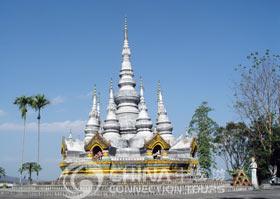 Beautiful and fascinating Xishuangbanna is famous all over the world, and is a very popular Yunnan tourist destination.
Beautiful and fascinating Xishuangbanna is famous all over the world, and is a very popular Yunnan tourist destination.
Jinghong city is the capital of Xishuangbanna Dai Nationality Autonomous Prefecture. The city retains the characteristics of the tropical rainforest landscape by which it is surrounded; it also has a strong flavor of the customs of the local national minority groups. Among local scenic spots are Peacock Lake, Manting Park, the Dai Nationality Culture and Customs Garden, Manjinglan Nationality Flavor Food City, and the Tropical Botany Institute.
Constructed in 1203, White Pagoda was shaped after bamboo shoot. A brick - clay conned structure with solid core, it consists of a mother pagoda, several baby pagodas and six huge clay dragons. The White Pagoda was famous at home and in southeast Asian countries for a Buddhist " holy deed ", that is, the half of footprint 80 cm long and 58 cm wide, which said to be left by Sakyamuni, the founder of the Buddhist religion. The White Pagoda is a key cultural relics unit under State protection.
Constructed in 1204, the Black Pagoda was originally of black appearance upon completion. It is a calabash - shaped hexahedron 18 - meter -high 7 - story pagoda embraced with eight colored clay dragons. In the past 800 years , it has been painted several times, and now it is of silver white appearance . The Black Pagoda is also famous at home and abroad for a footprint 160 cm long and 60 cm wide left by deity Pazhao Getama.
Seating elegantly on the hill behind the Menlong Village, Menglong Township, 70 km from Jinghong city is Menglong White Pagoda, while his brother, the Black Pagoda in Damenglong is located on a small hill, west of Damenglong Township and 73 km from the Jinghong. Jinghong is 709 kilometers from Kunming. Travellers have a choice of coach or air transport.
Ban Na Buddhist Pagodas
Among these pagodas, Manfeilong white Pagodas were built in 1207, which are pagoda groups with one "parent pagoda" and eight subsidiary ones commonly called White Pagodas. The "parent pagoda" is about 20 meters high while subsidiary ones 10 meters, all of which are built of bricks, looking like bottle gourds. The pinnacles stand straightly high touching the blue sky.
In history, the Dai folks tamed elephants and used elephants to work for them, and Xishuangbanna was known as the "kingdom riding on elephants" and famous for "battles with elephants"; and the place also intensified its communication with inland Chinese because it donated tamed elephants and elephant trucks to the rulers. Since the Dai folks regard elephant as the symbol of the mighty, the strong, the chaste and the steady, they treat elephants as the key topic in all forms of arts and literatures; and they pin their pursuit for "the true, the kind and the beautiful" on elephants.
